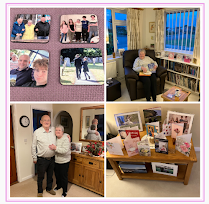"Dear LF/VLF group and further VLF watchers :-)
After another very successful, exciting and fascinating /p VLF experiment i want, as usual, thank all the many (>=24) receiving stations who took the time to arrange a suitable antenna/receiver, PC and to watch the experiment and take some interesting captures. The transmissions took place on 2 VLF bands, 33km (8970 Hz) and 58km (5170 Hz).
So, thanks to TF3HZ, SQ5BPF, G4WGT, G3KEV, Daniele Tincani, G3WCD, G3XDV,M0BMU, G3XBM, OK2BVG, OE3GHB, G4AYT, IK1QFK, DL3ZID, F4DTL, OE5ODL, PA3CPM, PA3FNY, DL4YHF, DF6NM, DJ2LF, DD7PC (bold = 1st positive reception on VLF).
Special thanks to Halldor/TF3HZ who wasn't member of this group before but set up a very sensitive VLF receiver and even a most intersting grabber just by my email request. This is the first VLF detection between DL and TF. My signal appeared at up to 15 dB SNR in 4.5 mHz in 2404 km. This helps a bit to get some imagination how far a transatlantic detection is away.
Sorry to those who tried without success this time, like 4X1RF. The next experiment will come soon, maybe in about one month.
So, see you in the 11th experiment. :-)
Vy 73, Stefan/DK7FC'
9 Feb 2011
DK7FC's report on his 10th VLF test
This is an extract of the note from Stefan to the LF-reflector about his tests last weekend:
8 Feb 2011
HamSphere internet ham radio system
 |
| How HamSphere works |
User interface is via a simulated HF transceiver presented on the computer screen. The "feel" of the transceiver is remarkably good. Of course, being an internet based virtual amateur radio system, no amateur radio equipment is needed and no RF is radiated, yet the experience is very close to that of operating a real HF radio on the HF bands. For those unable to operate real radios because of planning restrictions or other problems, this system offers some of the fun of amateur radio again. It is like CQ100, but in my opinion better.
The transceiver uses Java technology and simulates all amateur radio bands from 160 to 6 meters. The software, plus a lot more information about this service, is available from http://www.hamsphere.com/ . The software works in Windows, Mac and Linux.
Using the system I just had a QSO with ZS4CCM in South Africa. It felt like a real "on air" HF QSO. It's no substitute for the real thing, but fun to use on occasions and when HF conditions are appalling.
6 Feb 2011
DK7FC copied well here on 8.97kHz
After a few false starts and faulty kit, I managed good copy of Stefan DK7FC's signals on 8.97kHz this afternoon with my loop in the garden and this simple preamp into Spectrum Lab running on the PC. S/N was around 5-7dB in a 4.52mHz bandwidth. He was also copied in Iceland at over 2400kms.
5 Feb 2011
JT65A on HF
Having seen the article on how to do this in the latest edition of Practical Wireless, I have installed the software and taken a listen/look. Main issue seems to be that the AGC in the FT817 is fierce and with close-by PSK31 signals it kills the gain of weak JT65A signals nearby. Anyway, it looks a useful mode. For HF use, download the HF tailored version at http://jt65-hf.sourceforge.net/. Not yet had a 2-way QSO but will soon when I've got the hang of this.
DK7FC/P active on VLF this Sunday
Stefan plans to be out with his kite antenna and around 100mW ERP on the VLF bands this weekend from 0700-1630utc transmitting on 3 frequencies starting with 8.970000kHz. Progress can be monitored on his grabber located 40km from the /P location. I am hoping to copy Stefan on 8.97kHz again as I managed it back in December.
These grabbers will show when he is active:
8.97kHz http://www.iup.uni-heidelberg.de/schaefer_vlf/DK7FC_VLF_Grabber.html .
6.47kHz/5.17kHz http://www.iup.uni-heidelberg.
These grabbers will show when he is active:
8.97kHz http://www.iup.uni-heidelberg.de/schaefer_vlf/DK7FC_VLF_Grabber.html .
6.47kHz/5.17kHz http://www.iup.uni-heidelberg.
4 Feb 2011
4m transverter - stage 1
 |
| 4m converter breadboard (2N3904 oscillator and NE602) |
Next stage is to breadboard the TX mixer and buffer stages.
Labels:
4m
E-field probe test on 8.76kHz away from home
 |
| G3XBM E-field probe for 8-9kHz |
1 Feb 2011
VLF earth-mode success: G6ALB copied at 3km on 8.76kHz
 |
| Spectran trace of G6ALB on 8.76kHz at 3km |
This is the first time I've received another amateur by earth-mode (conduction). The result suggests much further is possible. Experiments continue!
Labels:
8.76khz,
earth mode
PA1B analyses my 137kHz WSPR results
Bert PA1B has done some interesting "reverse analysis" of the WSPR reports I've given people. Working back from these you can estimate the lowest levels (in mW) that they could have used and still been copyable with me. This also gives a good guide to the likelihood of these stations receiving my weak signal. It is clear that M0BMU should be able to copy my 50uW ERP signal frequently (which he does) but that I'd need a lot more ERP to be able to get reports from the PA stations or SM6BHZ. See attached table from Bert.
29 Jan 2011
137kHz transverter update
 |
| Breadboarded 137kHz 8W transverter (ERP 50uW from antenna) |
 |
| Simple 137kHz QRP transverter - click for larger image |
Labels:
136khz,
137khz,
transverter,
wspr
Subscribe to:
Posts (Atom)








